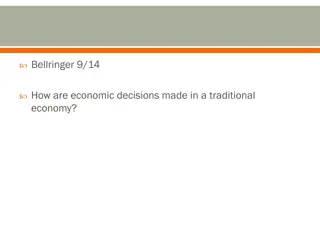Impact of New Economic Policy 1991 on Indian Economy
India implemented the New Economic Policy in 1991 to address the failures in fiscal policy and balance of payment crisis. This policy focused on delicensing, privatization, liberalization, and globalization of the economy. The changes led to increased competition, demanding customers, technological advancements, and the need for human resource development. The impact of these changes includes a shift towards market orientation, reduced budgetary support to the public sector, and the emphasis on exports for survival.
Download Presentation

Please find below an Image/Link to download the presentation.
The content on the website is provided AS IS for your information and personal use only. It may not be sold, licensed, or shared on other websites without obtaining consent from the author.If you encounter any issues during the download, it is possible that the publisher has removed the file from their server.
You are allowed to download the files provided on this website for personal or commercial use, subject to the condition that they are used lawfully. All files are the property of their respective owners.
The content on the website is provided AS IS for your information and personal use only. It may not be sold, licensed, or shared on other websites without obtaining consent from the author.
E N D
Presentation Transcript
NEW ECONOMIC POLICY AND ITS IMPACT ON INDIAN ECONOMY BY Dr. JAGADISH SINGH, ASSO. PROFESSOR & HEAD, Dept. of ECONOMICS, HARISHCHANDRA P.G.COLLEGE, VARANASI.
INTRODUCTION: India is the second highly populated country in the world. India is considering as a developing country and its economy as an emerging economy. After the world war II, there were so many colonial countries got freedom in 1947. After 1947 Indian economic and social system were entirely changed. At last urgently India reformed its economy in 1991 under the leadership of Narasimha rao as the Prime Minister and Dr. Manmohan singh as the finance minister. There were many arguments for liberalizing the Indian economy from 1960s onwards. But it was came in to reality only in 1991. To make reforms in the Indian economy there were many reasons.
1-FAILURE OF FISCAL POLICY AND BALANCE OF PAYMENT CRISIS (GULF WAR) 2- FOREIGN CURRENCY RESERVE CRISIS(THE FOREIGN CURRENCY RESERVE OF INDIA WAS ONLY ENOUGH FOR TWO WEEKS)
The main characteristics of new economic policy 1991 are: 1- Delicencing. Only six industries were kept under Licencing scheme. 2- Entry to private sector. The role of public sector was limited only to four industries, rest all the industries were opened for private sector also.
3- Disinvestment. 4- Liberalisation of foreign policy. The limit of foreign equity was raised to 100% in many activities, i.e., NRI and foreign investors were permitted to invest in Indian companies. 5- Liberalisation in technical area. 6-Setting up of promotion board (FIPB). This board was set up to promote and bring foreign investment in India. 7- Setting up of small scale industries and various benefits were offered to small scale industries. foreign investment
Three major components or elements of new economic policy: 1- Liberalisation. 2- Privatisation.& 3- Globalisation.
The common influence and impact of such changes in business and industry are: 1-Increasing competition. 2-More demanding customers. 3-Rapidly changing technological environment. 4-Need for developing human resources. 5-Market orientation. 6-Loss of budgetary support to public sector. 7-Export a matter of survival etc.
Conclusion: The policies of Liberalisation, Privatisation & Globalisation have brought positive impacts on indian business and industry. They have become more customer focus and have started giving importence satisfaction. The Indian businessman are facing global competition and many Indian companies joined the export business and got lot of success. For example , the Reliance, Videocon, MRF, CEAT Tires etc. to customer























